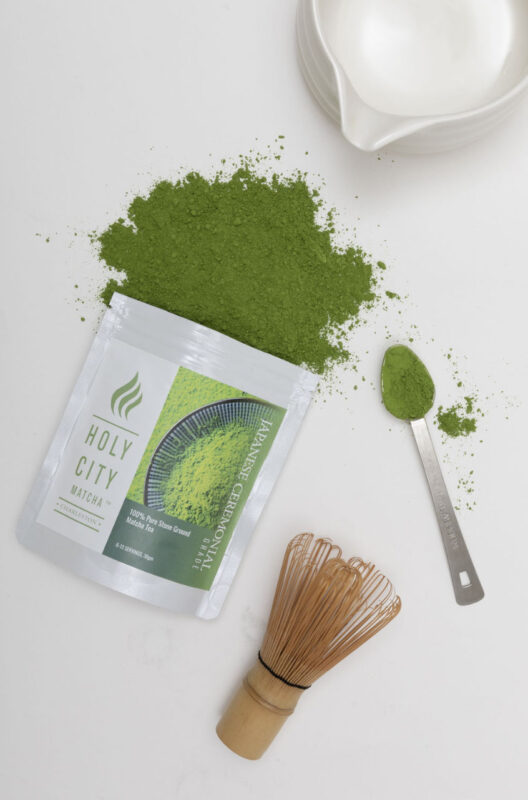The Benefits of Matcha Tea
Matcha, rich in nutrients and antioxidants, is gaining popularity as a plant-based energy booster and focus enhancer. With the rise of healthier lifestyles, it appeals to fitness enthusiasts and vegans alike, offering a delicious, nutrient-packed option that supports wellness and vitality.
Health Benefits of Matcha
Matcha green tea has been consumed for centuries by Buddhist monks, Samurai warriors, and millions of people in Japan.
The reason they continue to drink it is because of the amazing health benefits it provides simply by consuming it once a day.
Rich in antioxidants, particularly a group called catechins, which are rare in other foods. Among these, EGCG (epigallocatechin gallate) stands out for its exceptional ability to combat oxidative damage. It is world-renowned for its weight loss benefits, antioxidant content, energy-boosting properties, and much more.
These catechins, including EGCG, actively neutralize free radicals throughout the body, promoting overall health and longevity. By incorporating matcha into your routine, you can harness these powerful antioxidants for lasting well-being.
FAQ
Matcha
Matcha is a type of green tea; of the Camellia sinensis plant. It is a finely ground powder of specially grown and processed whole green tea leaves. The plants are shaded then carefully deveined and ground to produce matcha.
Matcha is primarily categorized into two grades: ceremonial and culinary. Ceremonial grade matcha is made from the youngest tea leaves and is intended for traditional tea ceremonies, offering a delicate flavor and vibrant green color. Culinary grade matcha, on the other hand, is slightly more bitter and is suitable for cooking and baking applications.
Ceremonial grade matcha is considered the highest quality due to its superior taste, vibrant color, and smooth texture. It is made from the youngest tea leaves, which are carefully processed to preserve their delicate flavor and nutritional content. This grade is ideal for traditional tea ceremonies and for those who wish to enjoy matcha in its purest form.
The production of high-quality matcha is labor-intensive and involves several meticulous steps, including shading the tea plants before harvest, hand-picking the finest leaves, and stone-grinding them into a fine powder. These processes contribute to its higher cost compared to other teas.
The timing of the harvest affects the quality and flavor of matcha. Leaves harvested during the first flush (early spring) are considered the highest quality, offering a sweeter and more delicate flavor. Later harvests yield leaves that are more robust and slightly bitter, often used for culinary grade matcha. Our matcha is premium ceremonial grade, sourced from the first harvest for the highest quality.
High-quality matcha has a vibrant emerald green color, indicating freshness and proper processing. Lower quality matcha may appear yellowish or brownish, which can result from improper shading during cultivation or oxidation during processing.
To prepare matcha, you'll need a bamboo whisk, a tea bowl, and a sifter to prevent clumps. Sift 1-2 teaspoons of matcha into the bowl, add a small amount of hot water (not boiling), and whisk vigorously in a zigzag motion until a frothy layer forms on top. Proper whisking ensures a smooth, clump-free beverage.
High-quality matcha offers vegetal grassy notes, subtle sweet nuttiness, and pleasant bitter undertones, if any. The flavor can vary depending on the quality and preparation method.
Matcha contains caffeine, with one cup (1/2 teaspoon of matcha powder) providing approximately 25-35 mg of caffeine, compared to 100-200 mg in a typical cup of coffee. Additionally, matcha contains the amino acid L-theanine, which promotes relaxation and counteracts the jittery effects of caffeine.
To maintain matcha's freshness, store it in an airtight container in a cool, dark place, preferably in the refrigerator. It's best consumed within a few months of opening to enjoy its optimal flavor and nutritional benefits.
Matcha is 100% pure green tea leaves that have been shade-grown, hand-picked, steamed, dried, and stone-ground into a fine powder. No additives or preservatives are involved in traditional matcha production.
Beyond traditional tea preparation, matcha is versatile and can be used in various recipes, including lattes, smoothies, baked goods, and savory dishes. Its unique flavor and vibrant color make it a popular ingredient in culinary creations.
Hojicha
Hojicha is green tea that has been put through a roasting process. It is this roasting process that colours the leaves a rich dark brown, and the change isn’t just in the colour. Hojicha gives off a toasted and nutty fragrance, and its flavour is mild and slightly smoky.
The timing of the tea harvest influences Hojicha's flavor and quality. Leaves harvested later in the season are typically used for Hojicha, as they are more mature and can withstand the roasting process, resulting in a deeper, more robust flavor.
The brown color of Hojicha is a direct result of its roasting process. Roasting the green tea leaves over high heat causes them to change from their original green hue to shades of brown or reddish-brown, distinguishing Hojicha from other green teas.
To brew Hojicha, use the following method:
• Tea-to-Water Ratio: Use about 1 teaspoon of Hojicha leaves per cup.
• Water Temperature: Heat water to approximately 90°C (194°F).
• Steeping Time: Allow the tea to steep for 30 seconds to 1 minute, depending on desired strength.
A traditional Japanese teapot (kyusu) is ideal for brewing, but any teapot or infuser can suffice. Avoid oversteeping to prevent bitterness.
Hojicha offers a toasty, nutty flavor with subtle caramel notes and a hint of smokiness. Its roasting process imparts a mild sweetness and eliminates the grassy undertones typical of other green teas, resulting in a smooth, mellow cup.
Hojicha contains lower caffeine levels compared to other green teas. The roasting process reduces its caffeine content, making it a suitable choice for those sensitive to caffeine or seeking a calming beverage for the evening.
To maintain Hojicha's freshness, store it in an airtight container away from light, moisture, and strong odors. While it has a longer shelf life than unroasted green teas due to its reduced moisture content, it's best consumed within six months of purchase for optimal flavor.
Hojicha is composed solely of roasted green tea leaves and stems, with no added ingredients. Its unique flavor profile is entirely derived from the roasting process applied to the tea plant components.
Due to its low caffeine content, Hojicha can be enjoyed multiple times a day without the risk of overstimulation. However, individual tolerance levels vary, so it's advisable to monitor your body's response and adjust consumption accordingly.
Beyond traditional brewing, Hojicha's versatile flavor makes it a popular ingredient in various culinary applications, including:
• Lattes: Combining Hojicha with steamed milk creates a creamy, toasty beverage.
• Desserts: Incorporated into ice creams, cakes, and pastries for a unique flavor.
• Savory Dishes: Used as a seasoning or infusion to impart a smoky depth.
Your Best Self Starts Here
Holy City Matcha is your daily dose of focus, wellness, and calm energy. Ready to sip the best?



